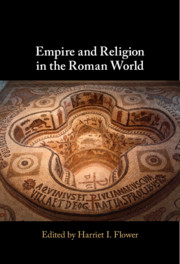Book contents
- Empire and Religion in the Roman World
- Empire and Religion in the Roman World
- Copyright page
- Frontispiece
- Contents
- Figures
- Table
- Contributors
- Acknowledgments
- Introduction
- Part I Empire
- Chapter 1 Germs and Empire
- Chapter 2 Imperial Integration on Rome’s Atlantic Rim
- Chapter 3 The Ambitions of Government
- Chapter 4 Contingency and Context
- Part II Religion
- Appendix: Bibliography of Brent D. Shaw’s Publications to 2020
- Index
- References
Chapter 3 - The Ambitions of Government
Sovereignty and Control in the Ancient Countryside
from Part I - Empire
Published online by Cambridge University Press: 26 August 2021
- Empire and Religion in the Roman World
- Empire and Religion in the Roman World
- Copyright page
- Frontispiece
- Contents
- Figures
- Table
- Contributors
- Acknowledgments
- Introduction
- Part I Empire
- Chapter 1 Germs and Empire
- Chapter 2 Imperial Integration on Rome’s Atlantic Rim
- Chapter 3 The Ambitions of Government
- Chapter 4 Contingency and Context
- Part II Religion
- Appendix: Bibliography of Brent D. Shaw’s Publications to 2020
- Index
- References
Summary
The chapter sketches an approach to a great challenge of contemporary ancient history, namely, the history whereby state power was extended into the ancient countryside. It commences with consideration of the operations that produced Roman taxonomies of city-states and villages: far from a simple consequence of recognition, the statuses of city-state and village alike were ascribed. The chapter directs attention to the decades when Rome ceased to treat with regions via networks of bilateral alliances and instead instrumentalized select city-states to dominate territories and peoples that were henceforth deemed non-political. On this basis, the chapter challenges the interpretive truisms that Rome “governed through city-states” or that it relied on preexisting institutions. What we should seek to bring into view is the political economics of republican empire: the related forms of fiscal domination and monopolies over law-making and law-applying institutions that the democratically constituted oligarchies of the ancient city exercised over others on behalf of Rome.
- Type
- Chapter
- Information
- Empire and Religion in the Roman World , pp. 71 - 93Publisher: Cambridge University PressPrint publication year: 2021
References
Bibliography
= L’Année Épigraphique
= Real-Encyclopädie der klassischen Altertumswissenschaft
= M. H. Crawford (ed.) Roman Statutes, 2 vols. (London, 1996)
= Supplementum Epigraphicum Graecum
= Tituli Asiae Minoris
= Cicero, Epistulae ad Quintum fratrem
= Cicero, In Verrem
= Dio Chrysostomus, Orationes
= Pliny the Elder, Naturalis historia
= Tacitus, Annales
Secondary Scholarship
- 15
- Cited by

